St Helena Ashore

Beez Neez now Chy Whella
Big Bear and Pepe Millard
Tue 11 Feb 2020 23:57
|
St Helena Ashore for the First
Time 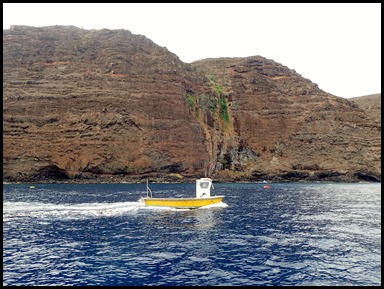 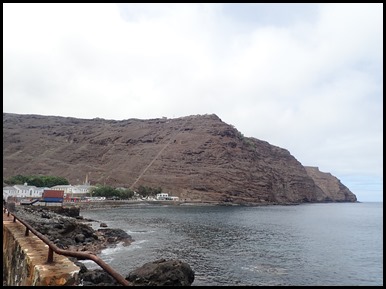 Danny arrived in the water taxi. He shares the role with his brother Paul –
each week they work the day six until twelve and one until seven, the following
week they swap duties. Getting ashore was a challenge
(I always have balance troubles to begin with) just as well there are dangling
ropes to grab hold of. St Helena is six miles by ten miles and is a small
British Overseas Territory, one of the remotest places on Earth located 1,200
miles west of the coast of Africa and 1,800 miles east of the coast of
Brazil.
 Looking across the
anchorage, Beez Neez is the furthest yacht out.
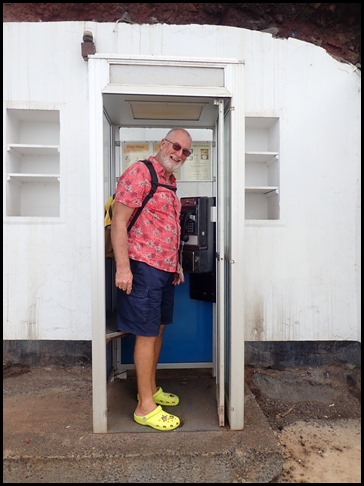 Along the quayside was a telephone box, with
bookshelves each side ????
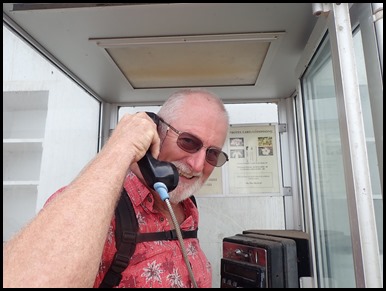 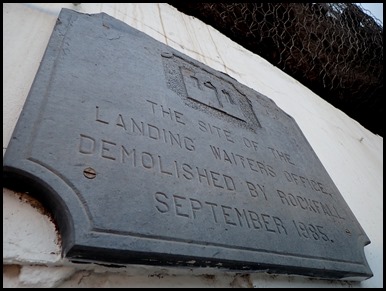 Himself
posed but behind the box was a plaque: The
site of the Landing Waiters Office demolished by rockfall September 1985.
So hope no one was injured. A little further on we found the blue door that the
really helpful workmen had pointed out and we ordered diesel from a jolly man
that will be delivered on the morrow. Onward in a zig-zag fashion through check in process. We began with the friendly
harbourmaster who then took us to Customs. Very easy and the Officer, Fiona gave
us a little map and loads of local information. One of her lovely colleagues
suggested two fingers of vodka after my next passage, never thought of that,
believe it or not always fancied a cup of tea. How anyone who has never, ever
been seasick can suffer land sickness in the form of having to hold on to the
taps whilst teeth cleaning in order to stop the sink bucking and rocking for a
day or two is beyond me, but there you are.
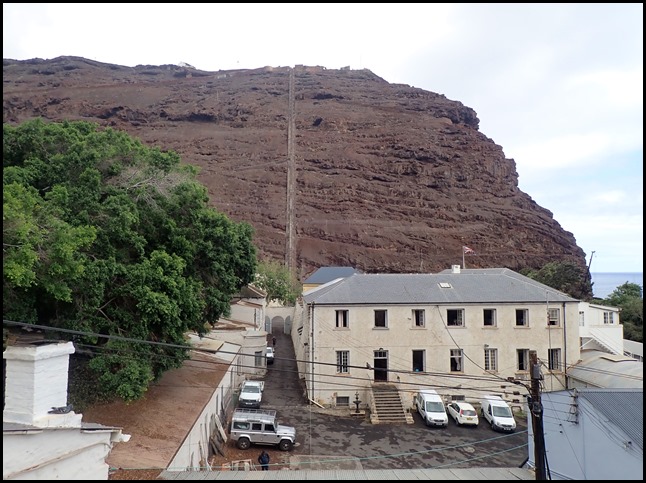 Obviously
cannot face the 699 steps up Jacob’s Ladder today but hope to do it before we leave. The
Ladder, a prominent feature of the town was constructed in 1829 to allow access
up and down from Ladder Hill Fort. Very much looking forward to seeing where
Napoleon stayed, an elderly tortoise called Jonathan and much more later in the
week.
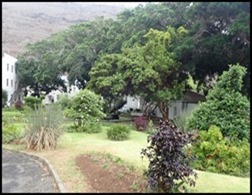 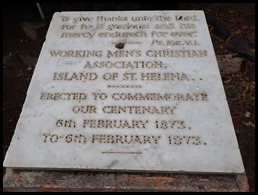 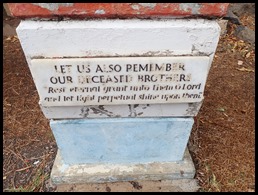 We cut through
The Garden with memorial
plaques.....
  .....a fountain and fish that didn’t
mind the fine rain that began to fall.
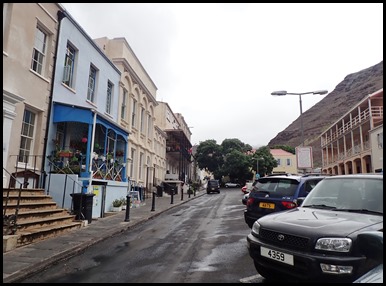 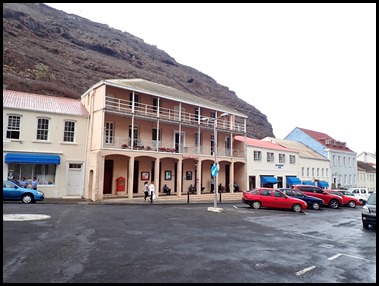 We were directed by very happy locals
toward Immigration, up Market Street and right at the
Post Office, up the hill to a big tree, raining
harder now. A very nice Control Officer told us all the Immigration Officers
were at the airport and would be back between three and four. Back down the hill
then.
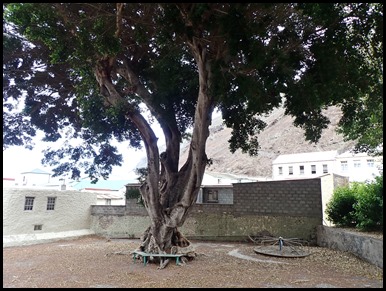 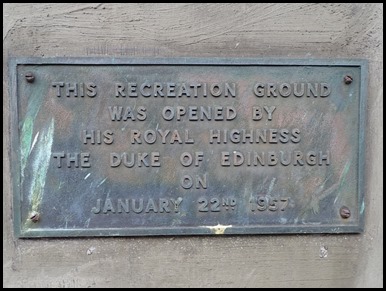 On our right, a very sad and lonely
play park, the plaque told
us that The Duke of Edinburgh opened it
in 1957.
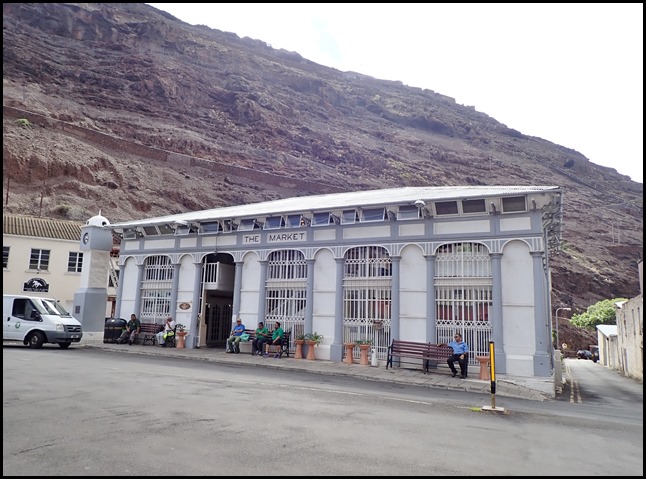 At the roundabout we admired The Market. The first market on the island began to
supply visiting ships around 1678 on the wharf near the original fort. By 1683
the market place was not used and was fitted up as the Session Courthouse.
Dampier (explorer and buccaneer) in 1691 commented that the market was only held
when ships docked, the East India Company took over in an attempt to
re-established a private enterprise. The
first indication of the predecessor to the modern market was under Governor
Walker in 1823 who instigated the building of a market at the end of the town,
open every day except Sunday.
The current market was built in
1865 from a prefabricated cast iron frame made by Gwynne & Co London. The
decision to use cast iron was due to the damage caused to many buildings by
inadvertent introduction of termites from a salvaged slave ship around 1860. The
area where the market is situated is know as The Bridge because the water from
the Run flows underneath the road.
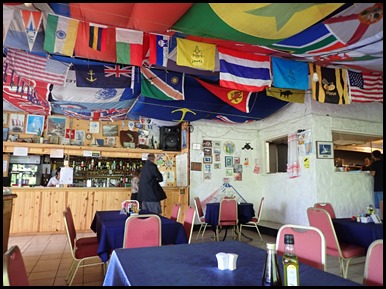  Anne’s Place, a favourite eatery with visiting yachties
served me four sausages (two saved for snacks), chips, salad and coleslaw for
five pounds. Bear had three lamb chops, chips, salad and
coleslaw for nine pounds fifty and very tasty our meals were. I had a
shandy. Vodka 1.65 a shot but the slim can to go with it.......2.50. Tap water
free and they don’t mind me charging up my laptop. I bought two hours of internet for 13.50 which allowed me to put a
couple of pictures on Facebook and do a few emails but sadly, not enough ooomph
to put any blogs on. So all the passage ones I have redone with pictures and
some of the backlog that always exists will have to stay on my laptop until we
get to Antigua.
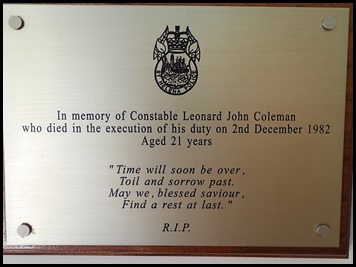  Back to Immigration, whilst we waited
for an officer to come and collect us we saw a plaque on the
wall by the door. Oh so sad. I asked the Control Officer what happened.
“In the wrong place at the wrong time. He was shot when he stepped in to a
domestic out in the countryside as a first responder”. Leonard will not be forgotten as the building carries his
name – Coleman House.
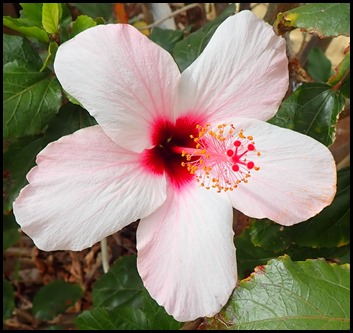 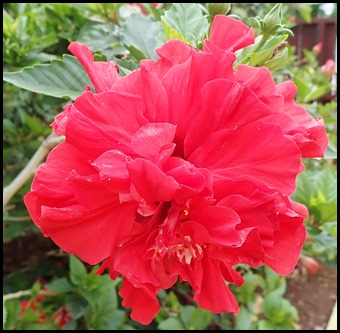 Soon done and stamped in. Lovely to
see blooms in the little garden at the combined
Police and Immigration buildings.
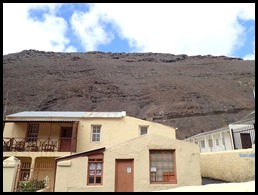 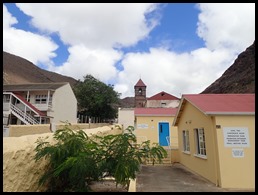 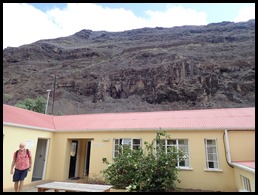 We stepped out and took in the vista.
On the left side of the road cliffs dominate. Looking
up the road the cliffs on each side and behind Bear
on the right side of the road, yes, cliffs.
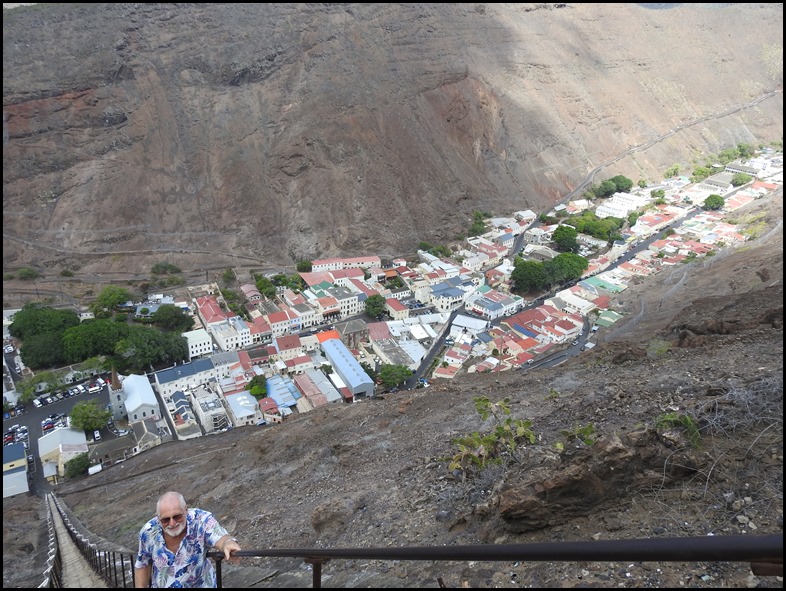 Jamestown is the
capital of this remote island nestled in the South Atlantic Ocean. This Georgian seaport nestles in a deep valley (a picture taken
on our day of exploring in a hire car) and retains a remarkable heritage.
Jamestown’s overwhelming texture tells of colonial conquest, slavery (the island
played a significant roll in the abolition process), imperialistic ideals, the
age of sailing ships, war and exile, bringing the past into the present.
1502: on a return trip from India, the
Portuguese admiral Joao de Nova sighted St Helena. The island was uninhabited
when he landed on the 21st of May 1502 – the anniversary of Emperor
Constantine’s mother, Saint Helena. A chapel was built using timbers from a ship
of the fleet.
1588:
Captain Thomas Cavendish, an English explorer, arrived aboard the
Desire during his round the world voyage.
1589: the Portuguese kept the island a secret and little
is recorded until 1589 when the Dutch pilot Johan van Linschoten described in
his journal the fleet landing in Jamestown, then known as Chapel
Valley.
1659: the
island annexed by the English East India Co.. The castle was built and Captain
Dutton commissioned to “settle, fortify and plant.” The island became important
as a staging post for ships going to and from the East.
1673: the
island, briefly taken by the Dutch, was recaptured for England by Sir Richard
Munden.
1700: the
population of some some hundred included soldiers, Hugenot refugees, victims of
the Fire of London and there were about three hundred simple dwellings, mostly
in Jamestown.
1772: the
building of St James’ Church began, completed in 1774, was built near the site
of the original chapel. The oldest Anglican Church south of the Equator. The
spire was added in 1843, removed in 1980.
1795: troops were sent from the
island to help the British secure the Cape colony.
1815: Napoleon was exiled to the
island.
1821: Napoleon died and was
recorded in St James Parish Register.
1834: the island was handed over
by the East India Company to British Crown rule.
1840: a Vice Admiral Court was
established to deal with slave ships which were brought here and the slaves were
cared for. Napoleon’s body was exhumed and sent to France.
1869: the opening of the Suez
Canal lessened the importance of the island as a port of call.
1890: the Zulu chief Dinizulu was
imprisoned here for seven years.
1899: the first stage of the
submarine cable from South Africa to England was landed.
1900: Boer prisoners of war from
South Africa were sent here.
1906: the British Army withdrew
their garrison.
1914 – 1918: the island was
garrisoned and the St Helena Regiment was reformed.
1939 – 1945: St Helena
contributed to the war effort as it did again in the Falklands
crisis.
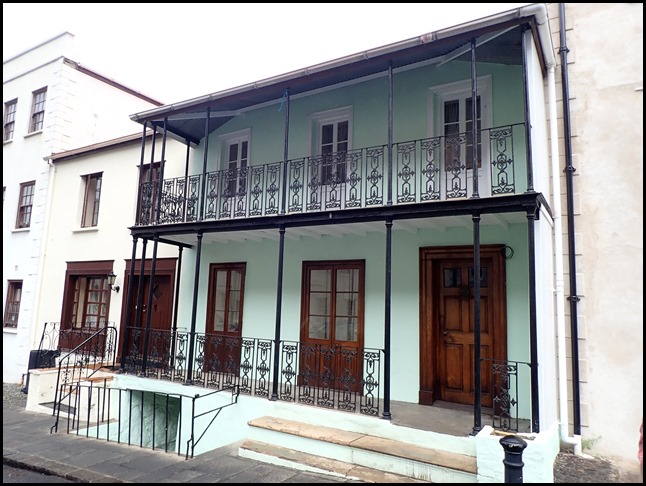 A typical verandah railing found all round the world wherever the
British have colonised. Jamestown feels like an
oldie-worldly Cornish town that I remember back in 1989 when I first worked
there. People chat in shops, men sit on the benches outside the famous market
building enjoying a beer while they chew the cud. As I sat and waited for Bear
to collect our insurance certificate (fifteen pounds for five days) a car
stopped to chat to someone for two or three minutes, no one behind bibbed or
looked in any way cross.
Good supermarkets, tins up a bit in
price but that is only to be expected considering how far they have to come to
sit on the shelf. Fruit and veg is a bit thin on the ground but delivery is
Thursday. Good butcher. Biggish fillet six pounds but frozen chicken wings and
thighs didn’t make my eyebrows shoot up too much........
We filled the day with poking around
the shops, I chose both our Valentine Day cards. Bought some solar lights for
Sleeping Indian, two tins of pulled pork as a treat for Bear at three pounds
fifty (spoiled rotten) and two tins of ham
at one pound sixty-nine. Back to Anne’s for a drink before bimbling to the six
o’clock water taxi. Once settled we met the crew of Finistere, so we
joined them for a drink, chatted and caught the last one at seven.
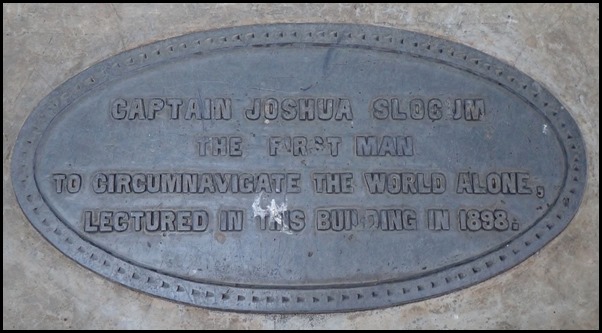 Back through the garden
we saw a plaque to Joshua Slocum who lectured here.
The island is famous for having Napoleon as a guest (in exile 1815 until his
death in 1821) but the island has also seen visits from the Duke of Wellington,
Captain Bligh, Edmund Halley, Charles Darwin, Captain Cook, King George VI, who
asked for his cine-camera to take photographs of the Queen who offered Jonathan
the tortoise a piece of banana. That was after he was stirred from a clump of
pampas grass during the royal visit to Plantation House in 1947. Many members of
the royal family have also visited over the years.
 We popped out
above the public swimming pool. Beyond a deep
‘gulley’ – The Run.
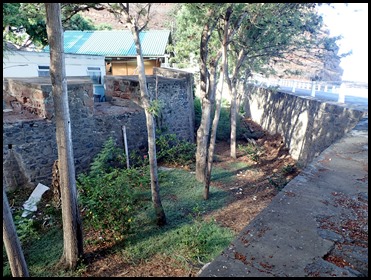 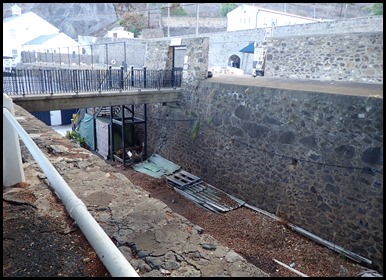 The Run was built by Victorian engineers with a dual
purpose: to serve as a sewer and to accommodate the water course. The rocks used
came from a local cave. The Run is paved with stone and painted with hydrated
lime. Nowadays it provides an excellent range for firing practice.
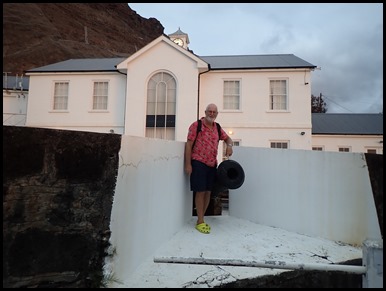 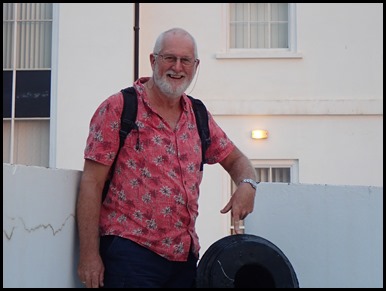 Outside Customs House the trigger finger
- poised as we have seen it so many times before.
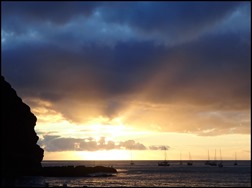 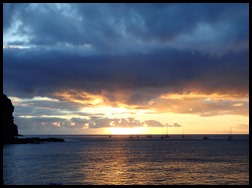  On the quayside
we watched quite a sunset.
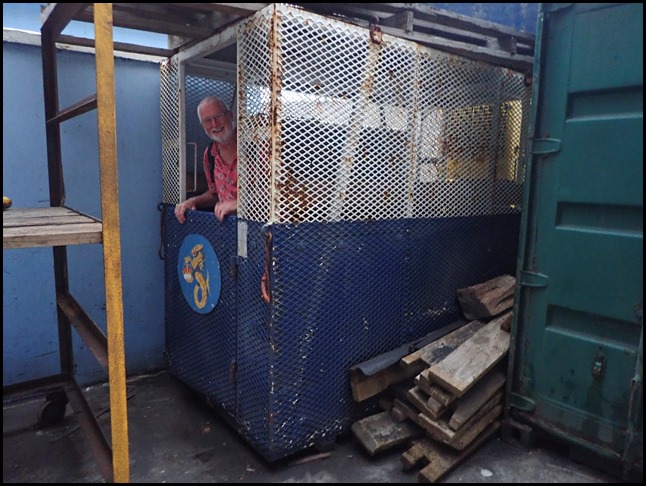 At the jetty
just before seven, we chatted to Danny about the supply ship (discontinued
service now the island has an airport). He took us behind some containers and
showed us this basket. Apparently, any disabled or
anyone not able to walk the gangplank was settled in this metal nest with simply
benches each side and swung ashore by crane. Somehow the worst funfair ride
comes to mind and I would think some very traumatised folk were very pleased to
set foot on terra firma. The more firmer the less terror, Oh Dear. Boom, boom.....
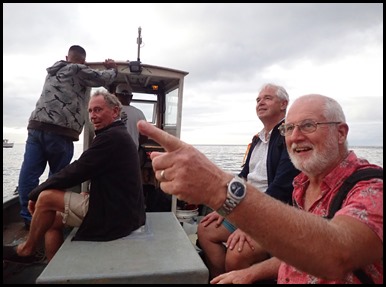 On the water
taxi with the crew of Finistere Bear pointed
ashore.
 Jacob’s Ladder was lit up.
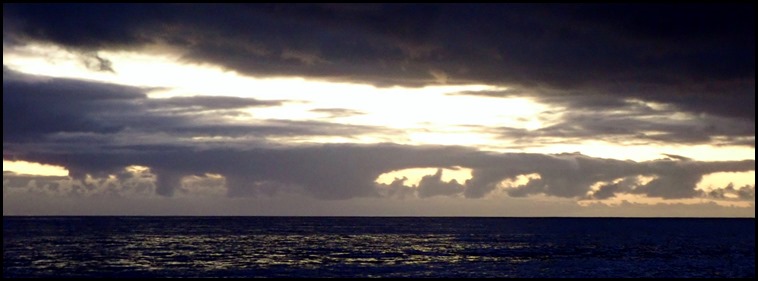 On our way back in the water taxi we
were treated to a strange sunset, it looked like a
train with passengers, mmm I guess so. Sat
in the cockpit, lost at backgammon AND Mex Train but we did soak our feet
throughout – another job ticked off the list once nails were cut.....ooo the
variety of my life, clean the fridge on the morrow while Bear deals with the
diesel delivery (1.43 per litre). Bracing showers off the back of the girl and
we both flopped into bed at local half past ten – to us half past
midnight.
ALL IN ALL VERY WELCOMING AND
HOMELY
FANTASTIC DAY
OUT |